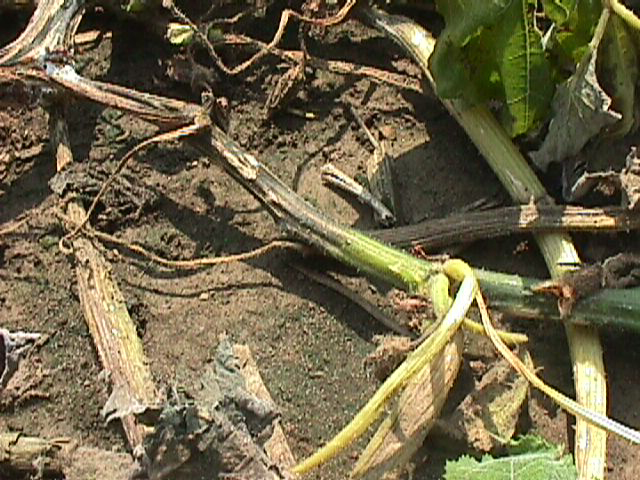Bulletin E310
Cucurbit crops (cucumber, pumpkin, summer and winter squash, melon, and gourd) are commonly grown in the home garden. In general, all cucurbit crops are susceptible to a number of common diseases on an annual basis. Some of these diseases are soil-borne (Phytophthora, Fusarium, Chaonephora, White speck), and others (Powdery and Downy mildew) are blown in on air currents from the southern United States each growing season. Control of these important diseases begins with scouting and proper diagnosis. Using proper crop rotations, resistant varieties, and cultural practices, will help reduce the chances for disease development in cucurbit crops grown in the home garden. Commonly found diseases of cucurbit crops in homeowner gardens, their diagnostic features and control measures, are outlined below.
Phytophthora Blight of Pumpkin
Phytophthora blight can be a serious disease of pumpkin grown in wet soil causing crown, vine, and fruit rot. If crown rot occurs, infected plants may suddenly wilt and collapse.
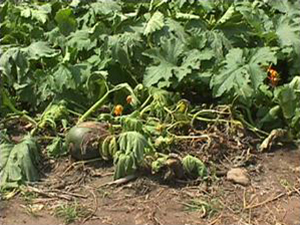
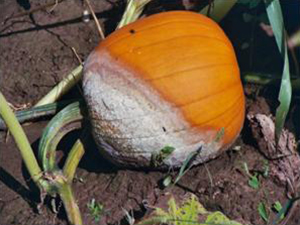
Symptoms on infected vines include water-soaked lesions which turn a blackish-brown color and have a slimy appearance. White, greasy spore masses may appear on infected vines under prolonged periods of warm, wet weather. Infected, wilted plants may appear to recover, but will eventually collapse and die as water uptake is shut down due to infection.
Late in the growing season Phytophthora blight may infect mature green or ripe pumpkin fruit. Symptoms of Phytophthora blight on infected fruit include the production of white, slimy spore masses, which develop on the undersides of infected fruit. As infection progresses fruit will become soft and collapse. Spores from infected crowns, vines, and fruit may spread to other healthy plants via rainfall and through puddling water which may be slow to drain off the soil surface. Once fruit are infected, they are no longer good and should be removed from the garden to prevent further spread of the disease. If symptoms begin to develop on fruit after harvest, they should be removed and properly disposed of.
Powdery Mildew
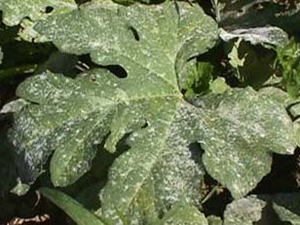
Pure white sporulating lesions typical of Powdery mildew infection.
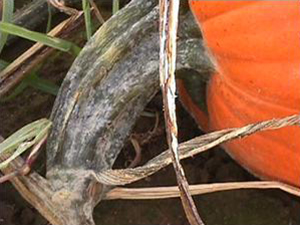
Powdery mildew infecting the stem of a mature pumpkin fruit.
Powdery mildew is one of the most important and destructive diseases of pumpkin in the home garden. If left uncontrolled, Powdery mildew can completely defoliate and kill a plant in a short period. Powdery mildew infections cause premature defoliation, which often leads to sunscald injury on fruit. Unlike other diseases in pumpkin, the development of Powdery mildew is favored by hot, dry weather conditions.
Symptoms of Powdery mildew include the production of white, fuzzy lesions on vegetative parts of the plant (leaves, petioles, vines) and stems of fruit. Lesions will often appear first on lower leaves. As new foliage develops it will become infected as the disease spreads throughout the planting. Powdery mildew infections will cause stems to become brown, dry, and brittle, which weakens the stem and shortens the shelf life of the fruit.
Anthracnose
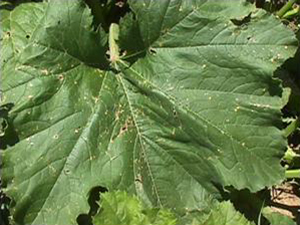
Anthracnose lesions on upper leaf surface of an infected pumpkin leaf. Notice ‘shotholes’ on heavily infected areas of leaf.
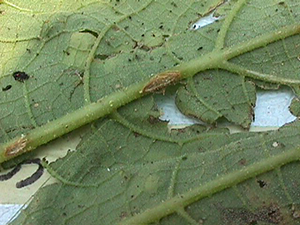
Spindle-shaped lesions caused by Anthracnose on ribs of an infected leaf.
Anthracnose is a common foliar disease during cool, wet weather. The fungus survives in the soil and is splashed with soil particles onto healthy leaves during rainfall or overhead irrigation. Symptoms include small, tannish-brown spots on the upper leaf surface. Turning the leaf over will reveal pinkish-orange, spindle-shaped lesions, which are limited to the veins of leaves. Masses of conidia (spores) are produced and are spread by splashing water (i.e., rainfall or overhead watering). Older lesions eventually turn brown and often fall out leaving ‘shotholes’ on infected areas of the leaf.
Plectosporium Blight or White Speck
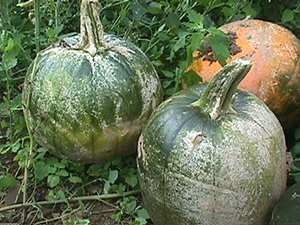
White speck lesions on surface of pumpkin fruit.
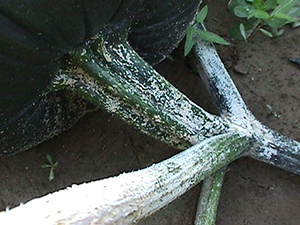
White speck lesions on petioles and stem of heavily infected pumpkin plant.
Symptoms of White speck include the production of very small, pure white diamond-shaped lesions on leaves, petioles, vines, and fruit. White speck can be extremely destructive in gardens with a history of the disease. White speck can cause premature defoliation and death in heavily infected plantings. On infected fruit, White speck produces superficial lesions on the surface of the rind, ruining fruit quality—although in most cases fruit will not completely rot.
Downy Mildew
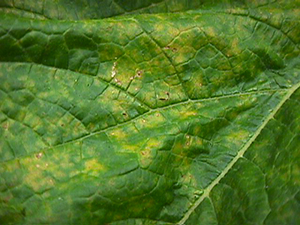
Symptoms of Downy mildew on the upper surface of an infected pumpkin leaf.
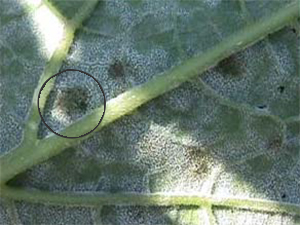
Symptoms of Downy mildew (circled) on underside of infected pumpkin leaf. Note: the white fuzzy growth is Powdery mildew.
Downy mildew is an important foliar disease of pumpkin which, unlike Powdery mildew, is favored by prolonged periods of cool, wet weather. Symptoms include the irregular chlorosis (yellowing) of the upper leaf surface. Downy mildew will only sporulate on the underside of leaves producing purplish-brown spores in white, fuzzy fungal growth. Heavy infection will lead to the browning (burning) of leaves and eventual death of the pumpkin plant in a matter of days if cool, wet weather persists. Premature defoliation caused by Downy mildew will reduce fruit size and predispose fruit to sunscald injury.
Choanephora Rot or Wet Rot

Chaonephora rot on newly developing pumpkin fruit.
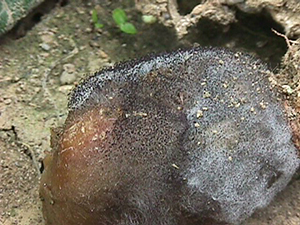
‘Bread mold’ like symptoms of Choanephora rot on heavily infected fruit.
Choanephora rot or Wet rot is a common problem on young developing fruit under extremely wet conditions during the period of fruit production. During cool, wet weather the fungus may be splashed into newly developing female flowers and young fruit. ‘Bread mold’-like symptoms will develop on infected flowers and fruit causing them to abort. Chaonephora rot often goes unnoticed because fruit set over a period of a few weeks during the summer months can be infected but hidden by the plant canopy. To reduce the chances for Wet rot developing, avoid overhead watering and use plant spacing which allows adequate airflow through the canopy. Remove any noticeably infected fruit from garden.
Fusarium Fruit Rot
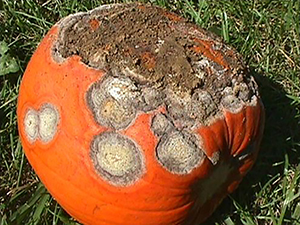
Symptoms of Fusarium fruit rot on infected pumpkin fruit with large purplish-red lesions and white fungal growth.
Fusarium fruit rot is an important soil-borne fungal disease of pumpkin. Fusarium fruit rot can cause significant losses when pumpkins are planted in the same area of the garden each year. Symptoms on pumpkin may go unnoticed until harvest. The fungus infects the ‘belly’ side of the fruit, which is in direct contact with the soil surface. Infections often begin as fruit begins to reach the mature green stage and continues as fruit ripens. Symptoms include the production of numerous slowly-expanding, round circular lesions. Lesions are often slightly sunken with reddish-purple margins. White fungal growth often develops in the center of lesions where masses of conidia (spores) are produced, which can infest the soil and other nearby fruit through splashing water.
Control of Fusarium fruit rot begins with proper crop rotations since the fungus can survive in the soil for many years. Do not plant pumpkin or any other cucurbit crop (cucumber, summer and winter squash, melons) in the same area of the garden for at least 3 to 4 years. Mulches such as straw placed in a 6-inch layer may help to reduce fruit rot by keeping pumpkin fruit from coming into direct contact with the soil surface. All infected fruit should be removed from the garden and properly disposed of. Pumpkins showing any symptoms should not be harvested because fruit will continue to rot in storage.
Angular Leaf Spot
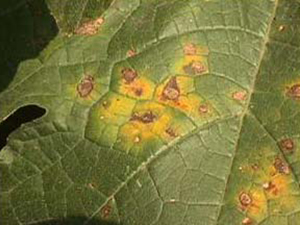
Shotholes produced when old Angular leaf spot lesions fall out of a leaf.
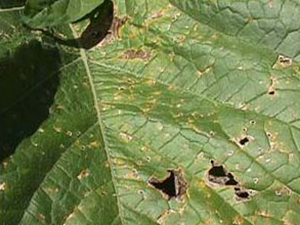
Angular-type lesions caused by Angular leaf spot on upper leaf surface of infected plant.
Angular leaf spot is another important bacterial disease of pumpkin. The bacterium can be seed-borne, therefore it is extremely important to start with ‘clean’ seed. Symptoms of Angular leaf spot (ALS) first appear as small, water-soaked (greasy) spots on the leaf surface. As lesions expand, they become delimited by leaf veins, thus developing their angular-shaped appearance. As lesions become aged and dry out, they may fall out leaving ‘shotholes’ on infected leaves. Development of ALS is favored by warm, wet weather. Under good growing conditions plants may outgrow the disease and produce a healthy fruit yield. In periods of heavy wind and rain, ALS may be splashed and carried to healthy fruit causing small, circular water-soaked lesions, which ruin aesthetic quality and predispose fruit to other pathogens.
Bacterial Wilt
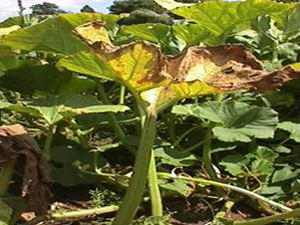
Symptoms of marginal leaf necrosis caused by Bacterial wilt on a pumpkin leaf.
Bacterial wilt can be a serious disease in pumpkin plantings if striped or spotted cucumber beetles are present when plants first emerge from the soil. The bacterium is vectored (carried) from plant to plant by the beetles as they feed on host tissue, particularly on cotyledons. Once inside the plant, bacteria eventually clog the vascular tissue, stopping the flow of water to leaves. Infections during the seedling stage typically go unnoticed until late in the growing season when plants suddenly wilt. Symptoms on infected plants include the marginal necrosis of leaves followed by complete collapse of the plant. Leaves tend to hang down in an umbrella-like appearance and eventually the entire plant will collapse and die. Control of Bacterial wilt begins with the proper control of the striped and spotted cucumber beetle early in the growing season as pumpkin seedlings emerge from the soil. Stripped and spotted cucumber beetles can be controlled with row covers or insecticides.
Mosaic Viruses
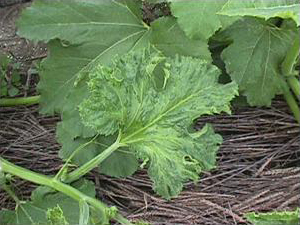
Mosaic symptoms caused by virus on a young, developing.
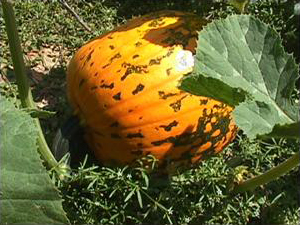
The irregular maturing of a pumpkin fruit on a plant heavily infected with a Mosaic virus.
Mosaic viruses can cause problems on pumpkin plantings in the home garden. Mosaic viruses are carried (vectored) from infected plants to healthy plants by numerous aphid species. Aphids are soft-bodied insects, which feed on the leaves of hosts by sucking sap from the plant. As the aphid feeds, the virus can be picked up and carried in mouthparts and re-transmitted to healthy plants. Symptoms of Mosaic virus infections include the irregular development of young leaves with irregular green patterns (hence, mosaic). Young leaves often become distorted and if a severe infection occurs early in the growing season, fruit may not set or develop properly.
In heavily infected plants, Mosaic virus may produce an irregular ripening of fruit or cause ‘bumpy’ fruit to develop. Unfortunately, control of Mosaic viruses is difficult because it is hard to control aphids on a regular basis in the home garden.
Planting pumpkin crops early, before aphid flushes arrive, may be useful. Using row covers to protect young plants from aphid feeding may also help reduce the amount of Mosaic virus in the garden.
White Mold or Sclerotinia Rot
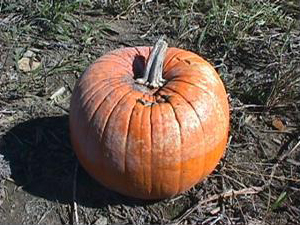
Symptoms of White mold in pumpkin fruit. Note how the stem end of the fruit becomes sunken.
White mold may cause problems in the home garden when pumpkins are planted in the same area each year and when other susceptible crops such as beans are grown. Development of White mold is favored by prolonged, cold wet weather. Symptoms often begin to show up as a soft, sunken area around the stem as the fruit reaches maturity. Infected fruit often collapse inward near the stem. Large, black fruiting bodies (sclerotia) may be produced around infected areas. Sclerotia serve as overwintering and long-term survival structures. A long crop rotation is necessary to help control White mold in the home garden. Infected fruit should be removed from the garden and properly disposed of.
Sunscald Injury
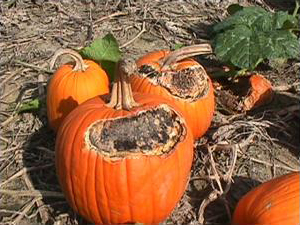
Symptoms of Sunscald injury with secondary infections on pumpkin fruit exposed to heavy sunlight after vines have collapsed.
Sunscald injury occurs when developing pumpkin fruit are suddenly exposed to heavy sunlight during the latter stages of fruit ripening. Sunscald injury often occurs when pumpkin plants become defoliated by Powdery mildew or Downy mildew, or when vines collapse due to Phytophthora blight or Bacterial wilt. Symptoms of Sunscald injury include the collapsing of rind tissue on the side of the fruit, which is in direct contact with the afternoon sun. Sunscald often develops into a pinkish-red color, which becomes flat in appearance. Over time, tissue may become tannish-brown as it ages and secondary pathogens invade the sunscald injured areas of the fruit.
Management Measures for Important Diseases of Pumpkin in the Home Garden
Controlling important diseases of pumpkin in the home garden begins with planting disease-tolerant varieties and using good cultural practices. New pumpkin varieties are released annually which are tolerant to diseases such as Powdery mildew and Fusarium fruit rot. Whenever possible, chose varieties which have tolerance to serious diseases.
Proper crop rotation is essential for reducing the chances of developing soil-borne diseases in pumpkin plantings. Pumpkin and other cucurbit crops should never be planted in the same area of the garden year-to-year and/or should never follow each other. Diseases which affect pumpkin will also affect other cucurbits such as zucchini, melon, cucumber, yellow summer squash, and winter squash. Allow at least 3 to 4 years in soils between pumpkin plantings if possible, to reduce diseases such as Fusarium fruit rot, White speck, Phytophthora blight and White mold. The longer soils are rotated out of pumpkins and other cucurbit crops, the better chances are for reducing soil-borne diseases. Always plant pumpkins in a well-drained soil. Water-logged soils are ideal places for diseases such as Phytophthora blight to develop. Mulching the soil with straw, hay or leaf litter at a 6-inch depth may help to reduce soil-borne disease such as Phytophthora and Fusarium fruit rot by preventing the fruit from coming into direct contact with the soil surface. Mulches may also help to reduce weed pressure and conserve soil moisture during the growing season.
For foliar diseases such as Powdery mildew, Anthracnose, Angular leaf spot, Choanephora, and Downy mildew, make sure plant spacings are wide enough to allow for good air circulation. A tight planting will create microclimates within the canopy, which can favor disease development. Avoid overhead watering at all costs. Overhead watering will create conditions which are favorable for disease development and help spread common diseases. If possible, use a soaker hose or drip irrigation to water plantings. This will ensure that foliage will remain dry. If you have to overhead water, make sure it is done in the morning to allow for adequate drying during the daytime.
Mature fruit should be removed from the garden as soon as it is ready. Leaving fruit in the garden can lead to Sunscald injury during warm days in the early fall, especially if fields have been defoliated by foliar diseases. Ripe fruit left in the garden also can be exposed to late season diseases such as White mold and Fusarium fruit rot or late season heavy frosts, which can shorten the longevity of the fruit.
Fungicide applications can be made to help suppress diseases such as Powdery mildew, Downy mildew, Anthracnose, and White speck. For the above diseases use a fungicide which contains the active ingredient known as chorothalonil, commonly sold in local garden centers and stores. Fixed copper is another chemical which can be used to help suppress bacterial diseases such as Angular leaf spot. To control Bacterial wilt, it is essential that striped and spotted cucumber beetles are controlled early in the growing season as seedlings emerge. Use a labeled insecticide spray or dust. When using any pesticide, always read and follow the label. Row covers can also be placed over newly emerging seedlings, which can keep insect pests such as beetles and aphids from feeding on young plants.
June 2020
Copyright © 2024 Rutgers, The State University of New Jersey. All rights reserved.
For more information: njaes.rutgers.edu.
Cooperating Agencies: Rutgers, The State University of New Jersey, U.S. Department of Agriculture, and Boards of County Commissioners. Rutgers Cooperative Extension, a unit of the Rutgers New Jersey Agricultural Experiment Station, is an equal opportunity program provider and employer.


